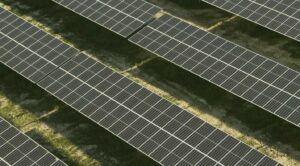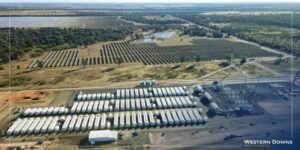The developer of Australia’s first utility-scale solar PV plant says such projects should be able to be constructed in Western Australia within two to three years, without the need for additional subsidies.
Jack Curtis, the head of business development in Asia for US-based First Solar, the world’s largest solar PV manufacturer, says the price of solar PV modules are falling rapidly, and by 2014/15 should be in the “mid teens” in cents/kilowatt hour, allowing it to compete with wind and gas in the WA market.
“That is when we will see the first utility-scale plant in WA built without the need for an extra subsidy,” Curtis told RenewEconomy in an interview. “Two years ago that was a target, now I would say that was a certainty.”
His comments come as two German companies announced this week that they would construct two large-scale solar plants in Spain, without the need for feed-in-tariffs that had supported the industry until now, and which had been recently withdrawn as part of the government’s debt reduction program.
Wuerth Solar says it intends to build a 287MW plant in the Murcia for $360 million, while Gehrlicher Solar says it plans a 250MW solar park in the Extremadura region for about $350 million. “We are seeking to open the way for subsidy-free solar in Spain, which is possible because grid parity is expected here next year,” Gehrlicher spokesperson Sonia Gomez told Bloomberg. “Institutional investors and banks are already showing tremendous interest in this model.”
Meanwhile, Germany’s two largest power companies, the nuclear giants E.ON and RWE, which had both opposed and lobbied against the expansion of solar, have said they will now invest in solar PV projects, even as the government winds back its subsidies. They said that the cost solar PV had fallen “more than they had expected“, and E.ON now plans to build at least 70MW of utility-scale solar a year from 2013, while RWE is also looking at investments in the Desertec project in North Africa.
First Solar’s Curtis says the longer-term cost path for the company’s technology in solar-rich WA will be lower than the mid-teens, and is heading towards 10c-14c/kWh. But, he says, it is not just about delivering on cost, it is also ensuring that utilities can recognise the value of solar delivering against day-time energy demand. “When you can match the load, and deliver the energy when it is needed, that delivers tangible economic value.”
Today, at a ceremony at the Greenough River plant, located some 50km south of Geraldton, the first of some 150,000 thin-film panels are being installed on the superstructure that has been put into place over the last few months. The 10MW plant – the first utility-scale plant to be built in Australia – should be operational by the middle of the year.
The panels have taken a circuitous route to Geraldton. They were made in Malaysia, shipped to Melbourne, where local manufacturer IXL installed them onto a racking system, and then trucked to Perth.
Despite the distances travelled, says Curtis, it was cheaper to do the componentry in Australia than overseas, indicating that Australia could create a significant manufacturing benefit from the widespread installation of solar PV, even if it is not making the panels.
“The more you can localise components and engineering – the more cost competitive it is to do it locally, rather than in China, for instance,” Curtis said. “It makes more economic sense to do some in Australia, and IXL have geared up a manufacturing footprint to do this. Hopefully more plants will follow soon.” Indeed, his take on local manufacturing opportunities is similar to that of Tindo Solar, which recently established a modules plant near Adelaide.
Next on Curtis’ immediate radar is the ACT solar auction, where First Solar is providing the technology for a bid by the local utility ActewAGL, which is among the favourites to get a contract in the “fast-track” component of the reverse tender.
Only those bidders with land, an agreed grid connection (ironically to ActewAGL) will be eligible for the fast-track component. It is expected that some of the more competitive bidding may come in the second round.
Curtis disagreed with the numbers in RenewEconomy’s story on Tuesday, which suggested that bidding for the ACT auction could come in the 12c-15c/kWh range – even if that is the target pricing range for WA in the coming years.
He said Canberra’s solar resources are not as good as WA’s, adding potentially 2c-3c/kWh, and the cost of finance and other balance of system costs is still more expensive than the US, for instance, and could add some 2c-4c/kWh to the costs. (And other have noted the ACT tariff is not indexed for inflation, which could add another 2c-3c/kWh).
Curtis says the key to deploying more solar will be the availability of financing from banks. The Greenough River project is debt-free and relies on a grant from the WA government and equity contributions from local utility Verve Energy and GE Finance.
However, Curtis says his team has been spending a lot of time with banks in recent months, “getting them up to speed” with the concept of solar. He says there is increasing appetite from banks to get involved in smaller projects, and this will increase once the Greenough plant is up and running, and banks can actually see and understand what it is they are financing.
“We are starting to see a lot of proactive interest from them. That’s a big change from just a year or two ago.” And, he says, there is a lot of interest from the major energy players, despite the controversy over the flagships program. (Two of the big three utilities have resubmitted bids to the flagships program, using First Solar technology). And he notes increasing interest in PV from other companies that used to be focused on wind, such as Pacific Hydro and Infigen Energy.
“We are seeing prices come down dramatically, it’s about preserving options,” he says. “This (Greenough) project will validate a lot of cost assumptions, and bring to bear a lot of know-how. It has helped us in re-bidding for the flagships program, not just submitting a much better price, but also from validating in-country experience. You don’t get the same level of buy-in until you can demonstrate the technology, and show how you can continue to bring down the next one.”
Verve Energy head of strategy and business development Tony Narvaez said the utility aims to develop other solar farm projects in the near future.






